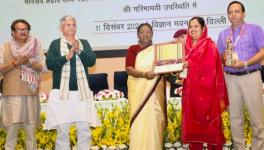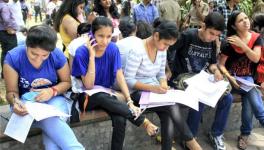Nuanced Casteism-Racism Impeding ST Students' Education Abroad

Representational Image. Image Courtesy: Flickr
In 2022, the Ministry of Tribal Affairs (MoTA) introduced a revised policy and guidelines for the National Overseas Scholarship (NOS), purportedly aimed at providing fully funded scholarships for Scheduled Tribe (ST) students to pursue higher studies in foreign universities within the top 1000 QS ranking.
However, the recent revisions in the policy seem to create further obstacles for these students rather than smoothening their experiences in accessing the opportunities.
Despite the NOS scheme's long-standing history from 1954 to 2024, its revisions and implementations have consistently fallen short in adequately supporting ST students. The operational details of the new guidelines do not appear to deviate from this troubling trend.
The revised scheme introduces a significant change in the eligibility criteria for ST students to be considered for the scholarship.
Section A of 4.4 of the 2022 NOS revised guidelines, titled ‘Preparation of the Merit List,’ states, ‘First priority will be given to the candidates who have already got admission and are pursuing their studies in the top 1,000 ranked foreign Institutes/Universities (as per the latest QS world ranking).’
While this new change appears to bring flexibility in the selection criteria compared to the NOS guidelines prior to the 2022 revision, which disqualified students already admitted and enrolled in foreign universities, the catch is in the subsequent associated note in the revised guidelines, which outlines, ‘If selected, the student will be entitled to the scholarship prospectively from the date of issuance of the award letter. No reimbursement will be made for the fee already paid by the student to the University and the expenses incurred on Insurance etc. However, the Maintenance and Contingency and Equipment allowance will be given in proportion to the number of months for the remaining financial year from the date of issue of the Award letter. For subsequent years, the student will be eligible for a scholarship covering all fees and other expenses (mentioned in para 3.5) for the remaining duration of the course (as mentioned in para 3.4).’
This policy adjustment raises two critical concerns. First, students who have secured admission and commenced their courses have already covered substantial expenses. This demonstrates that they have the capacity to finance their education, either through institutional support, external funding, or personal means.
Conversely, students de-prioritised under the new scheme, who have already secured admission with offer letters or yet to receive offer letters, typically hail from extreme financially constrained backgrounds. These students do not have the means to even consider applying for courses abroad without financial support like the NOS scholarship or any full scholarship. Moreover, they often lack the financial resources to cover tuition fees and associated expenses, making schemes like NOS their only viable option for pursuing higher education abroad. These are precisely the ST students the NOS scheme initially aimed to support, yet they now face increased barriers to access the very scheme.
Second, the scholarship amount provided under the revised scheme, starting from the date of the reception of the award letter, disregards any fees or expenses already paid by the student.
To comprehend the final amount of the scholarship awarded to the students after the expenses they have already incurred, consider the following analogy based on the rough cost breakdown by an NOS ST aspirant: “If a student gets admitted to a one-year master's program in the UK, the tuition fees range between 18,000 to 20,000 British Pounds (GBP) on average, which the student would be paying before joining the program. According to the revised guidelines of NOS, the student would not be eligible to get reimbursed for this major portion of the total study expenses. Additionally, the pre-2022 NOS scheme allocated an annual living expenses of 9,000 GBP along with an additional 1,000 GBP for health insurance for the UK. However, if the student has already completed six months of their program by the time of selection, verification, and reception of the final award letter (as has been the instances in previous years with delayed publication and final awarding of the scholarship in line with the starting of the academic years in foreign universities), the student, in such a case, would receive only the expenses for the remaining six-month period. This means out of the total of 30,000 GBP of total expenses incurred for pursuing this degree, MoTA would be paying only 5,000 GBP to the awardee, which is 16.67% of the total award as per the initial objective of the NOS scheme of providing fully funded scholarships to ST students.”
Over the 70 years of the scheme's existence, MoTA or the previous Ministry handling the implementation of the scheme has consistently fallen short of its initial objective, with less than 50% of the intended number of ST students benefiting from the programme.
According to the NOS policy, MoTA is mandated to select and fully fund 20 ST students each academic year. However, MoTA never had the budget to fully support all 20 students. So, it had been sending way fewer than 20 students for years.
MoTA revised its policy in 2022 to seemingly address criticisms and gaps in its previous approach. However, upon closer examination, it becomes evident that the revisions contain subtle yet significant loopholes that undermine the opportunities for ST students. The revised policy appears to fully sponsor 20 ST students annually, but in reality, it only selects those who are already studying abroad, excluding those who have yet to enrol or secure university offers.
This deliberate limitation in the policy aims to restrict the higher education opportunities for ST students. By selecting only those who are already abroad through other means, the Ministry avoids supporting students who may not have the financial means to study abroad independently. For instance, in the academic year 2023-24, MoTA published the first shortlist of 17 selected students for the NOS fellowship, out of which 15 had already been admitted to highly ranked foreign universities. These students had already paid their tuition fees and part of their living expenses.
Consequently, when the MoTA covers their remaining educational expenses, it primarily benefits financially, maintaining its previous approach of minimising expenditure on student support.
Furthermore, in 2022, the Ministry of Social Justice and Empowerment (MSJE) restricted NOS SC students of Social Sciences from conducting research on India-related topics. Similarly, the MoTA reduced the allocation of awards for students studying Social Sciences from five to only two through a revision of the same policy in that year. This reduction significantly limits the mobilisation of discourse around critical social issues such as caste oppression and state marginalisation of Adivasi communities.
And, that is precisely how caste works, being deeply-rooted into the system in universities and other public offices in India. The MoTA's tactics serve to dilute the original intentions of welfare policies designed for SC-ST and other caste-oppressed communities. By strategically implementing policies that appear supportive on the surface but contain hidden limitations and reductions, the MoTA is perpetuating systemic inequalities and hinders the empowerment of ST communities.
According to the All India Survey on Higher Education (AISHE) report for 2021-22, released by the Ministry of Education (MoE) in January 2024, there has been an overall increase in the number of Scheduled Tribe (ST) students in higher education. The report indicates that between the academic years 2014-15 and 2021-22, the enrolment rate of ST students has risen by 65.2%.
However, despite this increase, MoTA and the ruling right-wing Bharatiya Janata Party (BJP) have failed to address the stagnancy in increasing the number of available awards for ST students seeking higher education opportunities.
Also, there has been no corresponding increase in the budget allocation for the total scheme, despite the growing number of ST students pursuing higher education. Instead, the MoTA has chosen to revise policies in a manner that appears favourable to their objectives, aiming to create a positive public image of supporting the educational development of the ST community.
This approach is a form of bureaucratic and systematic caste and racist oppression. Despite the reported increase in ST student enrolment, they continue to have the lowest gross enrolment ratio in higher education in India, according to the AISHE 2021-22 report.
The BJP-led Union government's claims of significant increases in ST student enrolment under their regime can thus be seen as a mockery, considering the lack of substantive action to address the underlying issues faced by ST students in accessing higher education opportunities.
The writer is a post-graduate scholar from Telangana, and was formerly a Government of India National Overseas Scholarship Fellow at the International Institute of Social Studies, The Hague. He currently works as a Senior Researcher for the National Campaign on Dalit Human Rights (NCDHR). The views are personal.
Get the latest reports & analysis with people's perspective on Protests, movements & deep analytical videos, discussions of the current affairs in your Telegram app. Subscribe to NewsClick's Telegram channel & get Real-Time updates on stories, as they get published on our website.
























